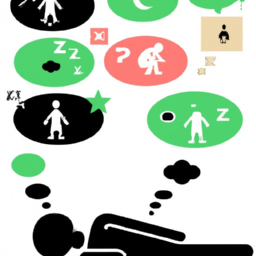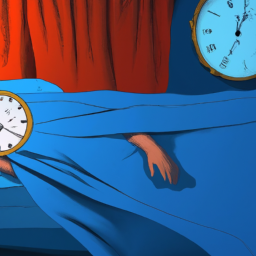Lucid Dreaming Techniques
Why Do I Have Lucid Dreams Every Night

Every night when I shut my eyes, I am whisked away to a realm outside of my conscious existence. A realm where I have the ability to soar, swim underwater, and manipulate the environment. I am referring to my lucid dreams, those rich and engrossing encounters that make me question why they occur nightly.
Lucid dreaming is a fascinating phenomenon that has captured the attention of scientists, psychologists, and spiritual seekers alike. It refers to the state of being aware that one is dreaming while still in the dream, allowing the dreamer to exert some level of control over the dream content.
While some people only experience lucid dreams sporadically, I seem to have them every night, leaving me with a sense of wonder and curiosity about the reasons behind this frequency. In this article, I will explore the theories, personal factors, techniques, benefits, and risks of lucid dreaming to shed some light on why I have these nightly adventures.
Key Takeaways
- Lucid dreaming can be influenced by various factors such as brain activity, neurochemistry, sleep disorders, medications, and psychological factors.
- Personal factors such as sleep habits, stress levels, diet, and mental health can also affect lucid dreaming.
- Techniques like reality testing, wake-back-to-bed, and mnemonic induction of lucid dreams can help induce lucid dreaming.
- Practicing mindfulness and relaxation techniques can reduce stress and anxiety, leading to more positive dream experiences.
Definition and Explanation of Lucid Dreaming
You may have heard of lucid dreaming, where you become aware that you are dreaming and can control the dream. It’s a fascinating phenomenon that has intrigued scientists and dreamers alike for centuries.
Essentially, lucid dreaming is when you have a dream where you know you’re dreaming and can influence the dream’s outcome. It’s like being in a virtual reality game where you can do anything you want, and your mind is the controller.
Lucid dreaming can be a thrilling experience, as you can explore your subconscious and let your imagination run wild. Some people use lucid dreaming as a tool for self-improvement, while others simply enjoy the adventure.
But why do some people have lucid dreams every night while others never experience them? That’s where the theories behind lucid dreaming come in.
Theories Behind Lucid Dreaming
I’ve always been fascinated by lucid dreaming and the idea of being able to control my dreams. As I dug deeper into the topic, I discovered that there are several theories behind why lucid dreaming occurs.
These theories include brain activity and neurochemistry, sleep disorders and medications, and psychological factors. Understanding these theories may help shed light on why some people have lucid dreams regularly, while others never experience them.
Brain Activity and Neurochemistry
When your brain is in a state of high activity and certain neurochemicals are released, it’s like a symphony orchestra playing a beautiful piece of music, creating a vivid and immersive experience in your lucid dreams every night.
Here are the main factors that affect brain activity and neurochemistry, leading to increased lucid dreaming:
-
REM Sleep: During REM sleep, the brain is highly active and the body is paralyzed. This allows for vivid dreams and a higher chance of becoming lucid.
-
Dopamine: This neurotransmitter is associated with pleasure, reward, and motivation. When dopamine levels are higher, it can lead to more vivid and memorable dreams.
-
Acetylcholine: This neurotransmitter is responsible for arousal and attention. Higher levels of acetylcholine can lead to more frequent lucid dreaming.
-
Serotonin: This neurotransmitter is associated with mood, anxiety, and sleep. When serotonin levels are imbalanced, it can lead to changes in dreaming, including more frequent lucid dreams.
As I explore the factors that contribute to my nightly lucid dreams, I also consider the impact of sleep disorders and medications.
Sleep Disorders and Medications
Sleep disorders and medications can greatly affect the quality and frequency of your dream experiences. For instance, sleep apnea is a common sleep disorder that can lead to a decrease in the amount of REM sleep you get. This is the stage of sleep where most of your dreams occur, including lucid dreams. Without enough REM sleep, you may not have as many opportunities to experience lucid dreaming.
Similarly, certain medications can also impact your dream experiences. Some antidepressants, for example, can increase the amount of REM sleep you get, leading to more vivid and intense dreams. On the other hand, medications like beta-blockers used to treat high blood pressure can decrease the amount of REM sleep you get, reducing the likelihood of lucid dreaming.
It’s important to keep in mind that these effects can vary from person to person and that you should always consult with a healthcare professional before starting or stopping any medications. With that said, there are also psychological factors that can influence your dream experiences.
Psychological Factors
Your state of mind and emotions can shape the landscape of your dream world, like a painter’s brush strokes on a canvas. Psychological factors such as stress, anxiety, and depression can greatly influence the content and frequency of your lucid dreams.
For instance, when you’re feeling anxious or stressed, your dreams may reflect those emotions, leading to more vivid and intense experiences. To better understand the role that psychological factors play in lucid dreaming, consider the following:
- Your current emotional state can influence the content of your dreams, including the level of lucidity you experience.
- Consistently practicing mindfulness and relaxation techniques can help reduce stress and anxiety, leading to more positive dream experiences.
- Trauma and past experiences can also affect your dream world, leading to recurring themes or nightmares.
- Therapy and self-reflection can help you better understand and process any emotional baggage that may be affecting your dream experiences.
With this in mind, it’s important to pay attention to your mental and emotional state, as it can greatly impact your dream world. In the next section, we’ll explore the frequency of lucid dreaming and what it may indicate about your sleep patterns.
Frequency of Lucid Dreaming
It’s pretty cool that I can have lucid dreams almost every night. But why does it happen to me so frequently?
The answer lies in the frequency of lucid dreaming. Some people can go months without having a single lucid dream, while others, like me, can have them almost every night.
Research suggests that the more frequently we have lucid dreams, the more likely we are to have them again in the future. This is because our brain becomes more accustomed to recognizing the dream state and we become better at controlling our actions within the dream.
However, this doesn’t mean that everyone can achieve frequent lucid dreaming. There are a number of personal factors that affect lucid dreaming, which we’ll explore in the next section.
Personal Factors that Affect Lucid Dreaming
As I’ve mentioned in the previous section, the frequency of lucid dreaming varies from person to person. However, there are personal factors that can affect how often you have lucid dreams. These factors include:
- Sleep habits: Irregular sleep patterns can make it difficult to achieve lucid dreaming.
- Stress levels: High levels of stress can interfere with your ability to remember your dreams, let alone control them.
- Diet: Consuming certain foods before bed can affect the quality of your sleep and your ability to lucid dream.
- Mental health: Conditions such as anxiety and depression can impact your ability to achieve lucid dreaming.
Understanding these factors can help you determine why you might be having lucid dreams every night. For example, if you have a consistent sleep schedule and a healthy diet, you may be naturally predisposed to lucid dreaming. On the other hand, if you have high levels of stress or a mental health condition, it may be more difficult for you to achieve lucid dreaming.
Now that we’ve explored some of the personal factors that can affect lucid dreaming, let’s move on to techniques that can help induce it.
Techniques to Induce Lucid Dreaming
So, you wanna learn how to induce lucid dreaming? Lucky for you, there are several techniques you can try out.
First up is reality testing, which involves regularly checking whether or not you’re dreaming throughout the day.
Another popular method is the wake-back-to-bed technique, where you set an alarm to wake you up in the middle of the night and then go back to sleep with the intention of having a lucid dream.
Finally, there’s the mnemonic induction of lucid dreams (MILD), which involves repeating a phrase to yourself before bed and visualizing yourself becoming lucid in a dream.
Reality Testing
To improve my ability to recognize when I’m in a dream, I try regularly performing reality checks throughout my day. These reality checks involve questioning whether I am dreaming or not by looking for certain signs. For example, I may check if I can breathe through my nose while pinching it shut, or if I can push my finger through my other hand.
To make this process easier, I have created a simple table to remind me of different reality checks that I can perform throughout the day. By doing this consistently, I am training my brain to recognize when I am in a dream and ultimately increase my chances of having a lucid dream. Now, onto the next step – the wake-back-to-bed method.
Wake-Back-to-Bed Method
You can increase your chances of experiencing a thrilling lucid dream by trying the wake-back-to-bed method. This technique involves waking up in the middle of the night, staying up for a short period of time, and then going back to sleep.
Here are three simple steps to help you try this technique:
- Set an alarm for about 4-6 hours after you go to bed.
- When the alarm goes off, get out of bed and stay awake for about 30-60 minutes.
- Go back to bed and focus on your intention to have a lucid dream.
The wake-back-to-bed method helps increase your chances of having a lucid dream because it disrupts your sleep cycle, making it easier for you to enter the REM stage of sleep where most dreaming occurs.
By following these simple steps, you can train your mind to become more aware during your dreams and increase your chances of having a lucid dream.
Now, let’s explore another technique called Mnemonic Induction of Lucid Dreams (MILD).
Mnemonic Induction of Lucid Dreams (MILD)
If you’ve ever struggled to achieve lucidity in your dreams, the mnemonic induction of lucid dreams (MILD) technique might just be the solution you’ve been searching for. MILD is a popular lucid dreaming technique that involves creating a strong intention to recognize when you’re dreaming.
This technique requires you to wake up after 4-6 hours of sleep, stay awake for 30-60 minutes while focusing on your intention to lucid dream, then go back to bed and drift off while repeating a phrase such as ‘the next time I’m dreaming, I’ll remember I’m dreaming.’
MILD has been shown to be effective in increasing the frequency of lucid dreams. It helps to train your brain to recognize when you’re in a dream state, leading to more frequent lucid dreams. Additionally, practicing MILD can also improve your overall dream recall, allowing you to remember more of your dreams in general.
With these benefits in mind, it’s no wonder why MILD is a popular technique among lucid dreamers.
Benefits of Lucid Dreaming
I’ve always been fascinated by the concept of lucid dreaming, and I’ve found that it has numerous benefits.
One of my favorite aspects of lucid dreaming is the opportunity it provides for creative exploration. In a lucid dream, I can let my imagination run wild and create anything I desire.
I’ve also found that lucid dreaming can be a helpful tool for problem-solving and personal growth. By confronting fears and challenges within the safety of a dream, I can build confidence and develop new solutions to real-life problems.
Creative Exploration
Get ready to experience a world of infinite possibilities as your mind takes you on a nightly adventure of creative exploration through lucid dreaming. Lucid dreaming provides an amazing platform for me to explore my creative side without any limitations.
I can conjure up any scenario, place, or character that I want and let my imagination run wild. It’s like having my own personal virtual reality headset that I can access every night!
Through lucid dreaming, I’ve been able to tap into my creativity and come up with new ideas for my personal and professional life. From designing new products to creating unique marketing strategies, lucid dreaming has been a game-changer for me.
And the best part is that I can do it all while I’m sleeping!
Now, let’s move on to the next section about problem-solving.
Problem Solving
Lucid dreaming can enhance problem-solving skills. Studies show that individuals who lucid dream are more likely to come up with creative solutions to complex problems. In a lucid dream, the dreamer is aware that they are dreaming and can actively participate in the dream world. This level of control and awareness can translate to problem solving in waking life. The dreamer is able to approach problems with a more open and imaginative mindset.
Lucid dreaming also allows for the exploration of different perspectives and scenarios, which can be useful in problem solving. By experiencing different outcomes in a lucid dream, the dreamer can gain insight into potential solutions and make better-informed decisions in waking life.
Overall, the practice of lucid dreaming can be a valuable tool for problem-solving and creative thinking. As I continue to explore the world of lucid dreaming, I’m excited to see how it can aid in my personal growth and development.
Personal Growth
You can experience tremendous personal growth through the practice of lucid dreaming. By unlocking new levels of self-awareness and creativity, you can impact your waking life in profound ways. By becoming aware that you’re dreaming and taking control of the dream, you can explore your subconscious mind and gain insights into your fears, desires, and beliefs. This can help you identify and overcome limiting beliefs and negative thought patterns that may be holding you back in your waking life.
Lucid dreaming can also be a powerful tool for creativity and problem-solving. By entering a lucid dream with a specific goal or question in mind, you can tap into your subconscious mind and access new insights and perspectives. This can lead to breakthroughs in personal and professional projects, as well as provide a unique space for artistic exploration.
However, it’s important to be aware of the risks and challenges that come with lucid dreaming, which will be discussed in the subsequent section.
Risks and Challenges of Lucid Dreaming
Unfortunately, delving too deep into the world of lucid dreaming can lead to a slippery slope of potential psychological risks and challenges that could leave you feeling lost in a maze of your own subconscious.
Firstly, it’s important to note that lucid dreaming often blurs the lines between reality and dreams, making it difficult to differentiate between the two. This could lead to a dangerous situation where the dreamer is unable to separate reality from their dream world and could act on impulses or thoughts that aren’t appropriate in their waking life.
Secondly, lucid dreaming can also cause a disruption in the normal sleep cycle, leading to sleep deprivation and exhaustion. This could result in a range of physical and emotional problems, including irritability, lack of focus, and even depression.
Lastly, the overuse of lucid dreaming techniques can lead to addiction, where the dreamer becomes obsessed with controlling their dreams and spends an excessive amount of time in their dream world, neglecting their responsibilities in the waking world.
While lucid dreaming has the potential to unlock the secrets of our subconscious and aid in personal growth, it’s crucial to approach it with caution and moderation.
In the next section, we’ll explore the connection between lucid dreaming and spirituality.
Lucid Dreaming and Spirituality
I’ve always been fascinated by the spiritual aspect of lucid dreaming. Dream Yoga, Shamanic Practice, and Astral Projection are three practices that have piqued my interest.
Dream Yoga is a practice that involves using lucid dreaming as a tool for spiritual growth and self-awareness. Shamanic Practice involves connecting with spiritual guides and ancestors through lucid dreaming. Astral Projection is a practice that involves leaving your physical body and exploring the astral realm through lucid dreaming.
Dream Yoga
By incorporating Dream Yoga into my daily routine, I have learned to control and enhance my lucid dreams every night. Dream Yoga is a practice that originated in Tibetan Buddhism and involves using meditation and visualization techniques to prepare the mind for lucid dreaming. Through Dream Yoga, I have been able to become more aware of my dream state and take control of my dreams, allowing me to explore and experience things that I never thought possible.
One technique that I have found particularly helpful in my Dream Yoga practice is the use of mantras. Mantras are repeated phrases or sounds that help to focus the mind and enhance concentration. In my Dream Yoga practice, I use mantras to help me stay focused and aware during the dream state, allowing me to stay in the lucid dream for longer periods of time. Here is an example of a mantra that I use:
| Mantra | Meaning |
|---|---|
| Om | A sacred sound that represents the essence of the universe |
| Mani | Jewel |
| Padme | Lotus |
| Hum | Represents the indivisible unity of all things |
With the help of Dream Yoga and the use of mantras, my lucid dreams have become much more vivid and meaningful. However, I have also found that there are other spiritual practices that can enhance my dream experiences even further. Transitioning into the subsequent section about shamanic practice, I have found that combining Dream Yoga with shamanic journeying has allowed me to explore even deeper levels of consciousness in my dreams.
Shamanic Practice
Combining Dream Yoga with shamanic journeying has led me on the wildest and most mind-bending adventures of my life. By incorporating shamanic practices, I’ve been able to access deeper levels of consciousness and connect with spirit guides who’ve helped me navigate the dream world in ways I never thought possible.
Here are three key insights I’ve gained from my shamanic dream practice:
-
Everything in the dream world is a reflection of my inner world. By exploring my dreams through a shamanic lens, I’ve been able to uncover hidden aspects of my psyche and gain a deeper understanding of myself.
-
Dreams are a portal to other dimensions. Through shamanic journeying, I’ve been able to visit alternate realities and connect with beings from other planes of existence.
-
The dream world is a powerful tool for healing. By working with my dreams in a shamanic context, I’ve been able to release emotional blockages and access deeper levels of healing.
As I continue to explore the boundaries of my dreaming mind, I’m excited to delve deeper into the world of astral projection and see where this journey takes me next.
Astral Projection
After practicing shamanic techniques for a while, I started to become interested in astral projection. I had heard that it was possible to leave your physical body and explore other realms while still being conscious. This sounded intriguing to me, so I began researching and learning about the practice.
Astral projection is the idea that your consciousness can separate from your physical body and travel to other dimensions or planes of existence. It’s often associated with lucid dreaming because both practices involve being aware while in a dream-like state. Through meditation and visualization, some people are able to induce an out-of-body experience and explore different realms.
It’s a fascinating concept, but I found that it wasn’t something that came easily to me. It’s interesting to consider the relationship between astral projection and lucid dreaming. While they are different practices, they both involve exploring different states of consciousness.
This brings me to the research and studies on lucid dreaming, which sheds light on the science behind this phenomenon.
Research and Studies on Lucid Dreaming
Numerous research studies have explored the fascinating world of lucid dreaming and its potential benefits. Here are three key findings that have emerged from these studies:
-
Lucid dreaming can improve problem-solving skills. When we have control over our dreams, we can use this opportunity to practice creative problem-solving techniques that can be applied in waking life.
-
Lucid dreaming can reduce anxiety and help with PTSD. By confronting and controlling the content of our dreams, we can gain a sense of mastery over our fears and anxieties, leading to a reduction in symptoms of PTSD.
-
Lucid dreaming can enhance creativity. By exploring the limitless possibilities of our dream world, we can tap into our subconscious and generate new ideas and perspectives that can inspire our waking lives.
Overall, the research into lucid dreaming suggests that it’s a powerful tool for personal growth and self-discovery. By learning to harness the power of our dreams, we can unlock new levels of creativity, problem-solving, and emotional resilience.
Frequently Asked Questions
Can lucid dreaming be dangerous or harmful in any way?
I’ve researched and found that lucid dreaming is generally safe. However, it can lead to sleep deprivation if done excessively. It’s important to maintain a healthy sleep schedule and not rely solely on lucid dreaming for rest.
How can lucid dreaming affect one’s mental health?
Lucid dreaming can have positive effects on mental health, such as improving problem-solving skills and reducing anxiety. However, it can also lead to sleep disturbances and may exacerbate certain mental health conditions, so it’s important to approach it with caution.
Is it possible to control the length of a lucid dream?
Yes, it is possible to control the length of a lucid dream. I use techniques like spinning or focusing on my surroundings to prolong the experience. However, it can still vary in length each time.
Can people who have never had a lucid dream learn to have them?
Yes, I believe it is possible for someone who has never had a lucid dream to learn how to have them. There are various techniques such as reality checks and keeping a dream journal that can help increase the likelihood of becoming lucid.
Is there a connection between lucid dreaming and sleep paralysis?
Yes, there is a connection between lucid dreaming and sleep paralysis. During sleep paralysis, you are aware but unable to move, which can lead to lucid dreams. However, not all lucid dreams occur during sleep paralysis.
Conclusion
In conclusion, lucid dreaming is a fascinating experience that has intrigued me for years. I’ve discovered various theories and techniques that can induce lucid dreaming, as well as the benefits and risks associated with it. It’s like entering a magical realm where my subconscious takes control, allowing me to explore the depths of my imagination.
Lucid dreaming is like a secret garden that only you can access. It’s a place where your wildest dreams can come true, and a powerful tool that can help you overcome fears, boost creativity, and gain insight into your inner self. While it may not be for everyone, those who have experienced it will attest to its incredible potential.
So, if you’re like me and have lucid dreams every night, embrace it and explore the endless possibilities that lie within.
Eislyn is a gifted writer whose words weave enchanting narratives within the realm of dreams. With a profound love for storytelling and a deep curiosity about dreams, Eislyn’s articles transport readers into vivid dreamscapes.
Her writing style is both eloquent and thought-provoking, captivating readers’ imaginations and inspiring them to dive deeper into the mysteries of their own dreams. Eislyn’s exploration of dream symbolism and interpretation adds depth and nuance to our content, making it an absolute pleasure for dream enthusiasts to engage with.
Lucid Dreaming Techniques
Why Do Some Dreams Seem So Real

Have you ever awakened from a dream feeling confused and disoriented? Perhaps you felt as though you were truly in the dream, experiencing it firsthand.
I remember one dream where I was being chased by a monster, and I could feel my heart pounding and my breath quickening as if it was all really happening. It’s a strange sensation, to be sure, but it’s not uncommon.
So why do some dreams seem so real?
Well, there are a few different factors at play here. For starters, our brains are incredibly complex, and the processes that take place during sleep are still not fully understood.
Additionally, the content of our dreams is influenced by a variety of internal and external factors, such as our subconscious thoughts and emotions, our daily experiences, and even the foods we eat.
In this article, we’ll explore some of the science and psychology behind why some dreams feel so vivid and lifelike.
Key Takeaways
- Different stages of sleep, especially REM sleep, can lead to highly active brain and paralyzed body, creating a different state of consciousness during sleep which contributes to the mysterious and fascinating experience of dreaming that feels inexplicably real.
- Dreams tap into deepest fears, desires, and experiences, and create a reflection of daily experiences in the subconscious mind, which is responsible for processing thoughts, emotions, and memories. External factors, such as sleep disorders, psychological factors like stress and anxiety, and cultural interpretations, can greatly impact dream vividness and emotional intensity.
- Memory consolidation occurs during sleep, and the amygdala is responsible for processing emotions during dreaming while the frontal cortex is involved in decision-making and problem-solving but with reduced activity. Understanding the impact of external factors can create a more conducive sleeping environment, and without enough sleep, the brain struggles to consolidate memories, leading to forgetfulness and difficulty retaining new information.
- Lucid dreaming is a state where one is aware of dreaming and can control actions and surroundings, allowing exploration of the subconscious. Various techniques can be used to achieve lucid dreaming, such as keeping a dream journal and reality testing by asking if dreaming throughout the day.
The Basics of Dreaming
Dreaming is a mysterious and fascinating experience that often feels inexplicably real. During sleep, our brains enter a state of consciousness that is different from our waking state. Our brains are still active during this state, but they’re processing information in a different way.
While we sleep, our brains go through different stages of sleep, including REM (Rapid Eye Movement) sleep. During REM sleep, our brains are highly active and our bodies are essentially paralyzed. It’s during this stage that we typically experience the most vivid and memorable dreams.
So, why do some dreams seem so real? It may have to do with the way our brains process information during this unique state of consciousness.
Next, we’ll delve into the role of the subconscious mind in dreaming and how it may contribute to the realism of our dreams.
The Role of the Subconscious Mind
When we’re asleep, our subconscious mind takes over and creates a vivid experience that feels just as real as the waking world. This is because the subconscious mind is responsible for processing thoughts, emotions, and memories that we may not be consciously aware of.
During sleep, the subconscious mind becomes more active and can create dreams that tap into our deepest fears, desires, and experiences. The subconscious mind is also responsible for storing and processing memories, which is why dreams can often be a reflection of our daily experiences.
However, not all dreams are a direct representation of our waking life. Sometimes, the subconscious mind can create entirely new scenarios and experiences that we may not have experienced before. Understanding the role of the subconscious mind in dreaming is an important step towards unlocking the mysteries of our nighttime experiences and the science of memory consolidation.
The Science of Memory Consolidation
As I lay in bed at night, my brain is hard at work, replaying and consolidating the memories of my day like a movie projector on repeat. This process, known as memory consolidation, is a crucial aspect of our brain’s function. It helps us process and remember important information, while discarding unnecessary details.
During this process, the brain takes the memories from short-term storage and transfers them to long-term storage, making them more permanent. Memory consolidation occurs during sleep, when our brains are in a state of rest and relaxation.
This is why it’s crucial to get enough sleep each night, as it allows our brains to properly process and store memories. Without enough sleep, our brains may struggle to consolidate memories, leading to forgetfulness and difficulty retaining new information. So, while it may seem like we’re just lying in bed doing nothing, our brains are actually hard at work consolidating memories and preparing for the next day.
The Brain’s Processing During Sleep
So, I’m fascinated to learn about the brain’s processing during sleep.
Two key areas of interest are the amygdala and frontal cortex.
The amygdala is responsible for processing emotions and is active during dreaming, which may explain why some dreams feel so real.
The frontal cortex, on the other hand, is involved in decision-making and problem-solving, but its activity is reduced during dreaming, which may explain why our dreams can be illogical and bizarre.
The Role of the Amygdala in Dreaming
The amygdala plays a crucial role in making dreams feel intensely vivid and realistic. Here are four ways that the amygdala affects the dreaming experience:
-
Emotion regulation: The amygdala is responsible for regulating emotions, and this function spills over into our dreams. This is why we often wake up feeling strong emotions like fear, anxiety, or happiness after dreaming.
-
Memory consolidation: The amygdala is also involved in consolidating memories during sleep. This means that the emotional content of our dreams can help us store and recall memories better.
-
Visual processing: The amygdala receives visual information from the eyes and processes it to create vivid mental images. This is why dreams often feel like watching a movie or experiencing a realistic simulation.
-
Fight or flight response: The amygdala is responsible for triggering the fight or flight response in dangerous situations. During a nightmare, the amygdala may interpret the dream as a threat and activate this response, causing physical sensations like sweating or increased heart rate.
As important as the amygdala is for dreaming, it’s not the only brain region involved. The function of the frontal cortex in dreaming is also worth exploring.
The Function of the Frontal Cortex in Dreaming
Our brains’ frontal cortex plays a crucial role in shaping the content of our dreams. This region of the brain is responsible for many higher-order cognitive functions, such as decision-making, planning, and working memory. During REM sleep, the frontal cortex becomes less active, allowing for more random and associative thoughts to arise. However, even though the frontal cortex is less active, it still plays an important role in the content of our dreams.
Research has shown that the frontal cortex is responsible for things such as setting the scene, creating characters, and controlling the plot of our dreams. This means that the events and people we encounter in our dreams can be influenced by our memories, desires, fears, and emotions. Additionally, the frontal cortex is also responsible for creating a sense of self in our dreams, allowing us to experience them as if we are actually there. So, while our dreams may seem incredibly vivid and real, they are actually the result of our brain’s complex processes.
As we’ve seen, the frontal cortex plays a significant role in shaping the content of our dreams. However, other factors can also influence our dreams, such as external stimuli or events in our lives. In the next section, we’ll explore how these external factors can impact the content of our dreams.
The Influence of External Factors
You might wake up feeling like you’ve just experienced a vivid dream because external factors can affect the intensity of your dreams. For example, if you’re sleeping in a room that’s too hot or too cold, your body may be uncomfortable and restless, causing your dreams to feel more intense and vivid.
Similarly, if there’s a lot of noise coming from outside your window or within your house, your brain may incorporate those sounds into your dream, making it feel more realistic.
In addition, the amount of light in your sleeping environment can also affect your dreams. If you’re sleeping in complete darkness, your brain may create more visual imagery in your dreams to compensate for the lack of external stimuli. On the other hand, if there’s a lot of light in your room, your dreams may be less vivid because your brain is receiving more visual information from the environment.
Understanding the impact of external factors on dream intensity can help you create a more comfortable and conducive sleeping environment, which may lead to more restful sleep and more enjoyable dreams. As a result, you may even be able to harness the power of your dreams for lucid dreaming.
Lucid Dreaming
I’m excited to talk about lucid dreaming! For those who are unfamiliar, lucid dreaming is when you become aware that you’re dreaming while you’re still within the dream.
This realization can allow you to take control of the dream and even manipulate its contents. There are various techniques you can use to achieve lucid dreaming, and we’ll explore some of the most effective ones.
Definition and Explanation
If you’ve ever had a dream that felt like reality, it’s likely because your brain is unable to distinguish between the two states.
Lucid dreaming is a state where you are aware that you are dreaming, and you can control your actions and surroundings. It’s a fascinating phenomenon that allows us to explore our subconscious mind and experience things that we wouldn’t be able to in the waking world.
During a lucid dream, you can fly, teleport, and even talk to your subconscious mind. The experience of lucid dreaming varies from person to person, and some people are able to achieve it naturally, while others need to practice certain techniques.
However, the benefits of lucid dreaming are numerous, and it’s a skill that anyone can learn. By mastering the techniques for achieving lucid dreaming, you can unlock your mind’s potential and have incredible experiences that you never thought were possible.
Techniques for Achieving Lucid Dreaming
As I mentioned earlier, lucid dreaming is when you become aware that you’re dreaming and can control the content of the dream. It’s a fascinating experience that many people would like to achieve. So, how can you achieve lucid dreaming? There are several techniques you can try.
One technique is reality testing, where you ask yourself if you’re dreaming throughout the day. If you do this habitually, you may start to do it in your dreams and realize that you’re, in fact, dreaming.
Another technique is keeping a dream journal and writing down your dreams every morning. This helps you become more aware of your dreams and may help you recognize when you’re dreaming.
There are also various meditation and visualization exercises you can do to prepare your mind for lucid dreaming. With practice, anyone can achieve lucid dreaming and experience the wonder of controlling their dreams.
Now, while lucid dreaming is a fascinating experience, it’s important to note that some sleep disorders can negatively impact your dreams. Let’s explore some of these disorders and how they affect our sleep and dreams.
Sleep Disorders
You may experience vivid and lifelike dreams if you suffer from certain sleep disorders. These disorders can disrupt your sleep cycles, leading to intense and unforgettable dreams.
Here are three sleep disorders that may cause you to have exceptionally realistic dreams:
- Rapid Eye Movement (REM) Sleep Behavior Disorder: This disorder causes people to physically act out their dreams while sleeping, which can lead to intense and vivid experiences.
- Sleep Apnea: People with sleep apnea often experience fragmented sleep, which can lead to more vivid dreams. Additionally, the low oxygen levels caused by sleep apnea may lead to hallucinations and intense dream experiences.
- Narcolepsy: This neurological disorder can cause people to fall asleep suddenly and unexpectedly, often leading to vivid and intense dreams during the rapid onset of REM sleep.
Sleep disorders are just one factor that can contribute to the realism of our dreams. Next, we’ll explore how psychological factors can also influence our dream experiences.
Psychological Factors
Psychological factors, such as stress and anxiety, can greatly impact the vividness and emotional intensity of our dreams – studies have shown that up to 70% of people who experience high levels of stress report having more vivid and disturbing dreams. When we are under stress, our minds are working through unresolved issues and worries, and these thoughts can manifest themselves in our dreams. Additionally, anxiety can also cause our brains to be hyperactive during sleep, leading to more intense dreams.
To further understand the relationship between psychological factors and dream vividness, I created a table to outline some common sources of stress and their potential effects on dreams:
| Source of Stress | Potential Effects on Dreams |
|---|---|
| Work-related stress | Dreams about being unprepared or failing at work tasks |
| Relationship stress | Dreams about conflict or betrayal |
| Financial stress | Dreams about loss or failure |
| Health-related stress | Dreams about illness or death |
It is important to note that not all dreams are negative or disturbing – some people report having more positive or creative dreams when they are feeling relaxed and content. However, understanding the impact of psychological factors can help us better interpret and cope with our dreams.
Moving forward, exploring cultural and spiritual interpretations of dreams can provide further insight into the significance and meaning of our dream experiences.
Cultural and Spiritual Interpretations
Exploring cultural and spiritual interpretations of dreams can uncover a deeper significance and meaning behind our nighttime visions.
In some cultures, dreams are believed to be messages from the divine or ancestors. For example, in some Native American cultures, dreams are seen as a way for ancestors to communicate important messages or warnings. Similarly, in ancient Egyptian culture, dreams were believed to be prophetic and were often interpreted by priests to guide the pharaohs.
In addition to cultural interpretations, many spiritual practices also emphasize the importance of dreams. For example, some religions believe that dreams can provide insight into one’s spiritual journey and can even bring one closer to the divine. In Buddhism, for instance, dreams are seen as manifestations of one’s karma and can be used as a way to cultivate mindfulness and awareness.
Overall, exploring cultural and spiritual interpretations of dreams can provide a unique perspective on the significance of our nighttime visions and can offer valuable insights into our personal growth and development.
Frequently Asked Questions
How does dreaming differ between different age groups?
As we age, our dream patterns change. Children have more frequent nightmares, while adults have longer, more complex dreams. Older adults tend to have less vivid dreams. However, the intensity of a dream can vary greatly from person to person regardless of age.
Can certain foods or medications affect the vividness of dreams?
Certain foods and medications can affect the vividness of my dreams. For example, eating spicy food or taking antidepressants can make my dreams more intense. However, I don’t think they necessarily make them feel more "real."
Is there a connection between dream content and a person’s personality traits?
I believe there is a connection between my dream content and my personality traits. I often dream about my fears, desires, and unresolved issues. These dreams reflect my subconscious mind and help me understand myself better.
Can recurring dreams be a sign of a deeper psychological issue?
Recurring dreams of being chased haunted me for months. My therapist uncovered that it was a manifestation of anxiety and a fear of failure. Once we addressed the root cause, the dreams stopped.
Are dreams affected by the time of day or duration of sleep?
I’ve noticed that my dreams vary based on the time of day and how long I sleep. Longer periods of sleep result in more vivid dreams, while napping during the day often leads to more fragmented and disjointed dreams.
Conclusion
So, why do some dreams seem so real? There are a multitude of factors that contribute to the vividness and intensity of our dream experiences. Our brains are constantly processing and consolidating information during sleep, which can sometimes result in incredibly lifelike dream scenarios.
Despite our scientific understanding of the mechanisms behind dreaming, there is still so much we don’t know about this mysterious realm of the mind. Perhaps it’s this sense of wonder and intrigue that keeps us coming back to our dreams, even when they leave us feeling confused, scared, or exhilarated.
So the next time you wake up from a particularly vivid dream, take a moment to reflect on the incredible power of your own mind and the endless possibilities that lie within it. Who knows what incredible adventures await you in your next dream?
Eislyn is a gifted writer whose words weave enchanting narratives within the realm of dreams. With a profound love for storytelling and a deep curiosity about dreams, Eislyn’s articles transport readers into vivid dreamscapes.
Her writing style is both eloquent and thought-provoking, captivating readers’ imaginations and inspiring them to dive deeper into the mysteries of their own dreams. Eislyn’s exploration of dream symbolism and interpretation adds depth and nuance to our content, making it an absolute pleasure for dream enthusiasts to engage with.
Lucid Dreaming Techniques
What Does It Mean When Someone Dreams That You Died

Have you ever experienced a dream in which someone you care about passed away? It can be a shocking and disconcerting moment, causing feelings of confusion and curiosity about its significance. I recognize that dreams can hold deep meaning for a lot of individuals.
In this article, we will explore the different theories and interpretations surrounding dreams of death, specifically when someone dreams that you have died. As humans, we spend a significant amount of our lives sleeping, and dreams are a natural part of that experience. While some dreams can be pleasant and enjoyable, others can be disturbing and confusing.
Dreams of death fall into the latter category, leaving us grappling with questions about our subconscious mind and the possible implications for our waking life. Throughout this article, we will examine various interpretations of dreams of death, including psychological, spiritual, cultural, and personal perspectives. We will also discuss how to cope with disturbing dreams and the potential impact they can have on our mental health.
So, let’s dive into the world of dreams and explore what it means when someone dreams that you have died.
Key Takeaways
- Dreams of death can hold significant meaning and may signify a major change or transition in one’s life.
- Dream symbols can have different meanings for different people and should be considered in the context of personal experiences.
- Interpreting dreams is not an exact science and takes time and patience to develop a unique method.
- Dreams can offer insight into our subconscious mind and help us better understand our emotions and behaviors.
Theories on the Meaning of Dreams
You might be wondering what your dreams are trying to tell you, and some theories suggest that they’re a manifestation of your subconscious thoughts and emotions.
One of the most common interpretations of dreaming about someone’s death is that it signifies a major change or transition in your life. It could be a sign that you’re letting go of old habits, beliefs, or relationships, and moving towards a new phase in your life. It could also indicate that you’re feeling overwhelmed by the pressures of your daily life, and that you need to take a break and focus on self-care.
Another theory is that dreaming about someone’s death is a reflection of your own fears and anxieties. It could indicate that you’re worried about losing someone close to you, or that you’re afraid of your own mortality. Alternatively, it could be a symbol of something that you’ve lost or that has ended in your life.
Whatever the interpretation, it’s important to remember that dreams are highly personal and can have different meanings for different people. In the next section, we’ll explore some common dream symbols and their interpretations, which may help you gain a deeper understanding of your dreams.
Common Dream Symbols and Their Interpretations
As we delve into the world of dream symbols, it’s fascinating to uncover the various interpretations behind common images.
For instance, dreaming about death can be a common occurrence for some people. This can be interpreted in different ways depending on the context of the dream.
If you dream about someone else’s death, it could mean that you’re worried about losing that person or that you’re experiencing a transition in your relationship with them.
On the other hand, dreaming about your own death could mean that you’re going through a significant change in your life or that you’re feeling overwhelmed by something.
It’s important to note that dream symbols can have different meanings for different people, so it’s essential to consider the context of the dream and your own personal experiences.
With that said, let’s move on to the next section about psychological interpretations of dreams.
Psychological Interpretations of Dreams
Get ready to explore the fascinating world of dream psychology and discover how our subconscious minds can reveal hidden emotions and desires through the symbols in our dreams.
Dreams are often considered as a reflection of our innermost thoughts and feelings. They can be influenced by our daily experiences and memories, as well as our fears and anxieties.
Psychologists believe that dreams serve as a way for our minds to process and cope with the emotions that we may not be able to express in our waking lives.
In terms of dreams about someone dying, it could represent different meanings depending on the individual’s personal experiences and emotions. It could be a reflection of a person’s fear of losing someone they care about, or it could symbolize a sense of loss or change in their own life.
Understanding the psychological interpretations of dreams can provide insight into our subconscious mind and help us better understand our emotions and behaviors. With that being said, let’s move on to exploring the spiritual interpretations of dreams.
Spiritual Interpretations of Dreams
Exploring the spiritual interpretations of dreams can provide a deeper understanding of the connection between our subconscious mind and the spiritual realm. Throughout history, dreams have been used for spiritual guidance and insight, and many spiritual traditions believe that dreams can offer messages from a higher power.
In some spiritual beliefs, dreaming of someone’s death may represent a symbolic rebirth or transformation. The death in the dream can be seen as a metaphor for shedding old beliefs or habits and making way for new growth and change.
Similarly, some spiritual interpretations suggest that dreaming of death can represent the end of a cycle or phase of life, and the beginning of a new one. This can be seen as a positive sign, indicating that something new and exciting is on the horizon.
Other spiritual interpretations suggest that dreaming of death can be a warning to pay attention to our own health and well-being, or to take better care of ourselves physically, emotionally, and spiritually.
Finally, some spiritual beliefs view dreams of death as a message from departed loved ones, offering comfort and reassurance that they’re still with us in spirit.
As we explore the various interpretations of dreams, it’s important to also consider cultural perspectives and how they shape our understanding of our dreams and subconscious mind.
Cultural Interpretations of Dreams
You may be surprised to learn that cultural interpretations of dreams can vary widely, depending on your background and experiences. In some cultures, dreaming of someone’s death is interpreted as a sign of good luck, as it is believed that death in a dream represents the end of a negative situation or phase in the dreamer’s life. In other cultures, dreaming of death is viewed as a bad omen, and can be seen as a warning of impending doom or tragedy.
To give you a better idea of how cultural interpretations of dreams can differ, take a look at the table below:
Culture Interpretation of Dreaming of Someone’s Death Chinese Sign of good luck Mexican Bad omen Indian Positive change
As you can see, the meaning of a dream can be heavily influenced by cultural beliefs and traditions. However, it’s important to note that not everyone within a particular culture will interpret dreams in the same way. Personal experiences, upbringing, and individual beliefs can also play a role in how someone interprets their dreams.
Personal Interpretations of Dreams
I believe that personal interpretations of dreams are important in understanding oneself.
One way to do this is by understanding your own dream language – the symbols and meanings that are unique to your subconscious.
Keeping a dream journal is also helpful in identifying patterns and recurring themes in your dreams.
Adjusting the paragraph structure in the input will allow for logical grouping of complete sentences on their own lines, with a double new line after. Don’t forget to use contractions.
Understanding Your Own Dream Language
Imagine feeling like a foreigner in your own mind, struggling to decipher the cryptic symbols that make up your dream language. This is the predicament that many of us face when trying to understand our dreams.
However, it’s essential to recognize that we’re the best interpreters of our own dreams because we possess the unique understanding of our personal experiences, emotions, and subconscious mind.
To understand your own dream language, it’s crucial to pay attention to your feelings, emotions, and symbols that appear in your dreams. By doing so, you can start to establish patterns, themes, and meanings that are unique to you.
Keeping a dream journal is an excellent way to document these patterns and develop a better understanding of your dream language. It’s essential to note that interpreting dreams isn’t an exact science, and it takes time and patience to develop your own unique method of deciphering your dreams.
Keeping a Dream Journal
Keeping a dream journal can be a fun and insightful way to unlock the mysteries of your subconscious mind. Here are some reasons why I find it helpful:
- It helps me remember my dreams more clearly and vividly.
- It allows me to identify recurring themes and patterns in my dreams.
- It provides a space for me to reflect on the emotions and feelings evoked by my dreams.
- It can help me gain insight into my own psyche and the issues I may be grappling with.
By keeping a dream journal, I’m able to understand myself better and gain a deeper understanding of my own thoughts and feelings.
However, sometimes our dreams can be disturbing and leave us feeling uneasy. In the next section, I’ll discuss some ways to cope with these types of dreams.
Coping with Disturbing Dreams
When I experience disturbing dreams, I find it helpful to explore coping strategies.
Seeking professional help, such as therapy or counseling, can offer valuable support and guidance.
Additionally, practicing self-care techniques like mindfulness, relaxation exercises, and good sleep habits can help manage the impact of these dreams on my well-being.
Seeking Professional Help
If you’re feeling scared or confused about a dream where someone close to you has died, it’s important to seek professional help to get the support you need.
Here are a few reasons why seeking professional help can be beneficial:
- A professional can help you process your emotions and thoughts related to the dream.
- They can provide tools and techniques to cope with the distressing feelings that may arise from the dream.
- Seeking help can also prevent the dream from affecting your daily life and relationships.
Remember, it’s okay to ask for help and take care of your mental health. Speaking with a therapist or counselor can be a valuable step towards finding peace and understanding after a difficult dream.
As you work through your emotions with a professional, you can also explore self-care techniques to support your healing.
Self-Care Techniques
Taking care of your mental health through self-care techniques is essential after experiencing a distressing dream. Dreams that involve the death of a loved one can be particularly unsettling, leaving you feeling vulnerable and anxious.
It’s important to take time for yourself to process the dream and work through any emotions that may have been triggered. One self-care technique that can be helpful is journaling about the dream and how it made you feel. This can help you gain insight into any underlying emotions or fears that may have been present in the dream.
Another technique is to engage in activities that bring you a sense of calm and relaxation, such as meditation, yoga, or spending time in nature. Taking care of yourself in these ways can help you better cope with the potential impact of dreams on your mental health.
The Potential Impact of Dreams on Mental Health
I’ve never really given much thought to how my dreams might be affecting my mental health until recently. After doing some research, I’ve learned that there is a potential link between the content of our dreams and mental health concerns like anxiety, depression, and trauma.
The idea that my dreams could be impacting my overall well-being is both intriguing and somewhat concerning, and I’m curious to explore this topic further.
Anxiety
You’re probably freaking out because dreaming about someone’s death can send your anxiety through the roof! It’s like your heart is racing a marathon and your mind is on a never-ending rollercoaster ride. The thought of losing someone close to you can be overwhelming and terrifying. It’s important to remember that dreams are not always a reflection of reality and that they don’t always have a deeper meaning. However, if you find that your anxiety is persisting and impacting your daily life, it may be helpful to speak with a mental health professional.
To better understand the impact of dreaming about someone’s death on anxiety, let’s take a look at the following table:
Causes of Anxiety Coping Mechanisms Fear of losing loved ones Practice deep breathing exercises Feeling of helplessness Engage in physical activity Inability to control thoughts Practice mindfulness and meditation
It’s important to remember that everyone copes with anxiety differently, and what works for one person may not work for another. If you find that your anxiety is persistent and overwhelming, it may be helpful to speak with a mental health professional to develop a personalized coping plan. In the next section, we’ll take a look at the potential impact of dreaming about someone’s death on depression.
Depression
I’ve experienced anxiety before, but depression is a whole other beast. It’s like a heavy weight that follows me around, making it hard to find joy in anything.
Even when things are going well, I can’t shake the feeling of sadness and hopelessness. It’s exhausting and it affects every aspect of my life.
When someone dreams that I died, it’s almost like a confirmation of my own feelings of worthlessness. It’s like they’re saying that the world would be better off without me. It’s a hard pill to swallow, but it’s a common theme in my own depressive thoughts.
I know that I have to work on changing this mindset, but it’s easier said than done. But despite the difficulty, I know that I have to continue trying. I can’t let the weight of depression hold me down forever.
In the next section, I’ll explore how trauma can affect our mental health.
Trauma
Trauma can have a lasting impact on our mental health, affecting our ability to cope with stress and form healthy relationships. When someone experiences a traumatic event, it can lead to a variety of mental health issues such as anxiety, depression, and post-traumatic stress disorder (PTSD). These issues can manifest in many ways, including recurring nightmares or dreams about the traumatic event.
In some cases, dreams about the death of a loved one can be a result of trauma. The loss of someone close can be a traumatic experience, and the dream may be a manifestation of the grief and stress associated with that loss.
However, it is important to note that not all dreams about death are related to trauma, and it’s important to debunk common dream myths to better understand their meaning.
Debunking Common Dream Myths
It’s important to note that not all dreams are symbolic or prophetic, and debunking common dream myths can help alleviate unnecessary worry or stress.
One common myth is that dreaming about death means someone is going to die in real life. However, this is not necessarily the case. Dreams are often a reflection of our subconscious thoughts and emotions, and can be influenced by a variety of factors such as stress, anxiety, and past experiences.
Another myth is that we can control our dreams if we just try hard enough. While it is possible to practice lucid dreaming and gain some control over our dreams, it’s not always easy or guaranteed. Dreams can be unpredictable and influenced by various factors such as medication, illness, and even what we eat before bed.
It’s important to remember that dreams are a natural and normal part of our sleep cycle, and while they can be intriguing and insightful, they should not be taken as literal predictions or warnings.
Frequently Asked Questions
Can dreams predict someone’s death or a tragic event in real life?
I don’t believe dreams can predict someone’s death or a tragic event in real life. While dreams can be meaningful and symbolic, they are ultimately a product of our subconscious and not a crystal ball for the future.
Is it common to dream of someone dying more than once?
I’ve had multiple dreams where someone close to me dies, so it’s not uncommon. Dreams are often influenced by our subconscious and can reflect our fears and anxieties.
Why do some people have recurring dreams of their own death?
I have recurring dreams of my own death because it’s a common fear. It could also be a sign of stress or anxiety. Consulting a therapist may help uncover deeper meanings.
Can dreaming about someone’s death be a sign of repressed emotions or trauma?
Dreaming of someone’s death may indicate unexpressed emotions or past traumas. Like a storm brewing in the distance, these feelings may surface in dreams as a warning to address unresolved issues.
Are there any common themes or patterns in dreams about death that can reveal their true meaning?
Common themes in death dreams, such as feeling lost, alone, or overwhelmed, can reveal underlying anxieties. These dreams may reflect a fear of change, loss of control, or unresolved grief. It’s important to explore these emotions and seek support if needed.
Conclusion
Personally, I believe that dreams are a manifestation of our subconscious mind and can reveal our deepest fears, desires, and emotions. While it can be unsettling to dream that someone has died, it doesn’t necessarily mean that it’ll come true in real life.
It’s important to explore the different interpretations of dreams, such as psychological, spiritual, cultural, and personal, to gain a better understanding of our own psyche. Furthermore, it’s important to remember that dreams can have a significant impact on our mental health and well-being.
Coping with disturbing dreams and debunking common dream myths can help alleviate anxiety and promote a better sleep cycle. In conclusion, dreams can be a powerful tool for self-discovery and personal growth, and we should approach them with curiosity and an open mind.
Eislyn is a gifted writer whose words weave enchanting narratives within the realm of dreams. With a profound love for storytelling and a deep curiosity about dreams, Eislyn’s articles transport readers into vivid dreamscapes.
Her writing style is both eloquent and thought-provoking, captivating readers’ imaginations and inspiring them to dive deeper into the mysteries of their own dreams. Eislyn’s exploration of dream symbolism and interpretation adds depth and nuance to our content, making it an absolute pleasure for dream enthusiasts to engage with.
Lucid Dreaming Techniques
What Do Dreams Tell Us About Ourselves

I have always been intrigued by dreams. When I was a child, I would wake up every morning excited to tell others about the unusual and vivid stories that unfolded in my mind while I slept.
As I grew older, my interest in dreams became more academic, and I began to wonder: what do our dreams tell us about ourselves? It turns out that dreams are a rich source of information about our inner selves.
From our emotions to our memories to our deepest desires, dreams offer a window into our subconscious minds. And while dream interpretation is still a largely subjective field, recent scientific research has shed new light on the meaning and significance of our dreams.
In this article, we’ll explore the science behind dreams, the different types of dreams, and what they can tell us about ourselves.
Key Takeaways
- Dreams provide valuable insights into our subconscious thoughts, desires, and fears.
- Recognizing patterns and symbols in dreams can reveal important information about our inner selves and relationships with others.
- Analyzing emotions and moods in dreams can help us unpack their meaning and make better decisions.
- Keeping a dream journal and utilizing dream interpretation resources can aid in understanding the messages our dreams are trying to convey.
The Science Behind Dreams
Did you know that the science behind dreams is still a mystery to experts? Despite decades of research, scientists haven’t been able to fully understand why we dream and what it tells us about ourselves.
However, they have come up with some theories that may explain the purpose of dreams. One theory is that dreams help us process our emotions and memories. During the day, we gather a lot of information, and when we sleep, our brain sorts through all of it and decides what to keep and what to forget. Dreams may be a way for our brain to consolidate our memories and emotions, making sure everything is properly stored.
Another theory is that dreams are a way for our brain to practice and prepare for future events. By simulating different scenarios, we can better prepare ourselves for whatever may come our way. These theories suggest that dreams play an important role in our mental and emotional well-being, and understanding them can help us understand ourselves better.
As we can see, there is still much to learn about the science of dreams. However, what we do know is that dreams can provide valuable insights into our subconscious and emotional state.
In the next section, we’ll explore the importance of dream interpretation and how it can help us gain a better understanding of ourselves.
The Importance of Dream Interpretation
As someone who’s always been fascinated by dreams, I believe that dream interpretation is an important tool for understanding ourselves on a deeper level.
One key aspect of dream interpretation is understanding symbolism and how our subconscious communicates with us through metaphor.
Recognizing patterns in our dreams can also provide valuable insights into recurring themes in our lives.
Finally, analyzing the emotions we experience in our dreams can help us uncover hidden feelings and unresolved issues that may be affecting our waking lives.
Understanding Symbolism
You’ll find that understanding symbolism in your dreams can be like unlocking a hidden language, where each symbol holds a unique meaning that can reveal insights about yourself. For example, dreaming about a snake can represent fear or danger, while dreaming about flying can represent freedom or a desire for independence. To help decipher the symbols in your dreams, it can be helpful to create a dream journal and jot down the symbols you see, along with any emotions or experiences connected to them.
To give you a better idea of common dream symbols and their meanings, here’s a table that breaks down some of the most frequently encountered symbols in dreams:
| Symbol | Meaning | Example |
|---|---|---|
| Water | Emotion, subconscious | Swimming, drowning |
| Teeth | Power, confidence | Losing teeth, broken teeth |
| Falling | Insecurity, fear of failure | Falling from height |
| Death | Change, transformation | Dying, rebirth |
By understanding the symbolism in your dreams, you can gain a deeper understanding of yourself and your subconscious thoughts and feelings. This can help you identify areas of your life that may need attention or change. Recognizing patterns in your dreams can also be a useful tool in uncovering recurring themes or issues that may be affecting your waking life.
Recognizing Patterns
Recognizing patterns in our dream symbols and experiences can provide valuable insights into our subconscious thoughts and emotions. By paying attention to recurring themes and symbols in our dreams, we can start to decipher what our subconscious is trying to tell us.
Here are a few ways recognizing patterns in dreams can help us better understand ourselves:
- Identifying recurring characters can give us clues about our relationships with those people in our waking lives.
- Noticing common emotions or themes can reveal underlying anxieties or fears we may be suppressing during our waking hours.
- Recognizing frequent activities or events can indicate areas of our life that we may need to focus on or improve.
- Paying attention to the setting of our dreams can provide insight into our overall mood and state of mind.
By analyzing these patterns and symbols, we can gain a better understanding of our subconscious thoughts and emotions. This knowledge can help us make positive changes in our waking lives.
In the next section, we’ll explore how to analyze our emotions based on our dream experiences.
Analyzing Emotions
It’s funny how our subconscious can reveal so much about how we truly feel, as analyzing the emotions in our dreams can lead to valuable insights into our inner selves. When we dream, our emotions can range from intense fear to overwhelming joy, and everything in between. By paying attention to these emotions and delving deeper into their meanings, we can better understand our own fears, desires, and motivations.
To do this, we can create a table that lists the emotions we experience in our dreams and what they may represent in our waking lives. For example, if we frequently dream of feeling anxious, it could be a sign that we are currently dealing with a lot of stress or uncertainty. On the other hand, if we often dream of feeling happy and content, it could indicate that we are satisfied with our current situation. By analyzing the emotions in our dreams and making connections to our waking lives, we can gain valuable insights into our own psyche and work towards personal growth and understanding.
Moving on to the next section about types of dreams, it’s important to note that not all dreams are created equal.
Types of Dreams
There are various types of dreams that can provide insights into our subconscious thoughts and emotions. For example, there are lucid dreams, which are dreams where you’re aware that you’re dreaming and can control the dream. These types of dreams can be very empowering as they allow you to confront fears and anxieties in a safe environment.
Nightmares, on the other hand, can be very unsettling and can reveal deep-seated fears or traumas that need to be addressed. Another type of dream is a recurring dream, which is when the same dream or a variation of it occurs repeatedly. These types of dreams can be particularly significant as they often represent unresolved issues or emotions that need to be dealt with.
Understanding the different types of dreams we have can help us identify patterns and themes in our subconscious, providing valuable insights into our psyche. With that said, let’s explore the connection between dreams and memory.
The Connection Between Dreams and Memory
By understanding how your brain consolidates memories during sleep, you can gain insight into the connection between your dreams and memory.
During sleep, our brain processes and consolidates memories, strengthening the ones that are important and discarding the ones that are not. This process is crucial for learning and retention of information.
Dreams are thought to be a byproduct of this consolidation process, as the brain replays and processes information from the day, creating new connections and associations between memories.
Furthermore, research has shown that emotional experiences are particularly important for memory consolidation during sleep. This means that if we have a particularly emotional experience during the day, it’s more likely to be replayed and consolidated in our dreams.
This is why we often have vivid dreams after a stressful or emotional day. Understanding the connection between our dreams and emotions can provide valuable insight into our emotional state and help us process and cope with difficult experiences.
The Relationship Between Dreams and Emotions
When we sleep, our brains process emotions and create new connections between memories, which can be reflected in our dreams. Dreams often provide a window into our deepest emotions and innermost thoughts. They can reveal our fears, desires, and anxieties, and help us process and make sense of complex emotions.
For instance, a dream that features a loved one who has passed away may evoke feelings of sadness and grief. Alternatively, a dream about a past relationship may trigger feelings of nostalgia or regret. By exploring these emotions and experiences in our dreams, we can gain a better understanding of ourselves and our emotions.
This can be especially helpful in times of stress or transition when we may need extra support to navigate our emotions. Understanding the emotions behind our dreams can also help us make better decisions and take actions that align with our values.
This leads us to the significance of recurring dreams, which we’ll explore in the next section.
The Significance of Recurring Dreams
After learning about the relationship between dreams and emotions, I couldn’t help but wonder about the significance of recurring dreams. I’ve had a few recurring dreams myself, and they always leave me feeling a little unsettled. What does it mean when we keep having the same dream over and over again? Is there a deeper meaning behind it?
As I researched, I discovered that recurring dreams can actually reveal a lot about our innermost thoughts and feelings. Here are five possible explanations for why we might have recurring dreams:
- Our subconscious is trying to tell us something important.
- We’re stuck in a pattern or habit that we need to break.
- We’re experiencing unresolved emotions or trauma.
- We’re afraid of something and need to confront our fears.
- We’re trying to work through a problem or decision in our waking life.
Understanding the significance of recurring dreams can be a powerful tool for self-reflection and personal growth.
As we delve deeper into the influence of culture and society on dreams, we’ll see how these recurring themes and symbols can also be shaped by our surroundings and experiences.
The Influence of Culture and Society on Dreams
Now, you may be wondering how the culture and society you live in can actually influence your dreams. Well, think about it this way: our experiences and surroundings shape our thoughts and behavior, which in turn can affect our dreams.
For example, if you live in a society that values success and achievement, you may have dreams about climbing the corporate ladder or winning awards. On the other hand, if you live in a society that places a lot of emphasis on family and relationships, you may have dreams about getting married or having children. These cultural and societal influences can even extend to the symbols and imagery that appear in our dreams.
It’s important to note that while culture and society can influence our dreams, they don’t necessarily dictate them. Dreams are highly personal and subjective, and can be influenced by a variety of factors.
That’s why using dreams for self-discovery can be such a powerful tool. By analyzing our dreams and looking for patterns or themes, we can gain insights into our subconscious thoughts, desires, and fears.
So, let’s explore this idea further and see how we can use our dreams to gain a deeper understanding of ourselves.
Using Dreams for Self-Discovery
Discovering more about who we truly are can be a powerful and emotional experience, and using our dreams as a tool for self-discovery can offer valuable insights. Here are five ways to use dreams for self-discovery:
-
Keep a dream journal: Writing down your dreams as soon as you wake up can help you remember them and uncover hidden meanings.
-
Look for patterns: If you notice certain themes or symbols appearing in your dreams, it may indicate something important about your subconscious.
-
Ask yourself questions: What emotions did you feel in the dream? What was the overall mood? Asking yourself these types of questions can help you unpack the meaning behind your dreams.
-
Use dream interpretation resources: There are books, websites, and even therapists who specialize in dream interpretation and can help you understand what your dreams are trying to tell you.
-
Pay attention to lucid dreams: Lucid dreams, where you’re aware that you’re dreaming, can provide a unique opportunity to explore your subconscious and gain insights into yourself.
As we continue to uncover the mysteries of the human mind, dream research will undoubtedly play an important role in our understanding of ourselves.
The Future of Dream Research
Looking ahead, I’ll be riding a wave of curiosity as dream research continues to unlock the secrets of the mind. The future of dream research is exciting, as new technologies and techniques are being developed to better understand the brain’s activity during sleep and the meaning behind our dreams.
One promising area of research is the use of neuroimaging techniques, such as functional magnetic resonance imaging (fMRI) and electroencephalography (EEG), to study the brain activity during sleep. This allows researchers to see which areas of the brain are active during dreaming and how they are connected to other parts of the brain.
Additionally, new methods of analyzing dream content, such as computer-assisted text analysis, are being developed to better understand the meaning behind our dreams. As the field of dream research continues to advance, we may gain a better understanding of the role that dreams play in our emotional and psychological well-being.
Frequently Asked Questions
Can dreams predict the future?
I don’t believe dreams can predict the future. While they may contain symbols or messages that resonate with our waking life, they are ultimately a product of our subconscious mind and cannot accurately foresee events that have not yet occurred.
Why do we forget most of our dreams?
My dreams are like sand slipping through my fingers, leaving only fragments behind. They fade as I wake, elusive and ephemeral. Perhaps they are meant to remain a mystery, hidden in the depths of my subconscious.
Can dreams be controlled or manipulated?
I can control my dreams using lucid dreaming techniques. By practicing reality checks and setting intentions before sleep, I can manipulate my dream content and even overcome nightmares.
Do animals dream?
Yes, animals dream. I’ve seen it in my dog’s sleep movements and vocalizations. Studies have shown that various animals experience REM sleep and brain activity similar to humans during dreaming.
Can dreams be harmful to our mental health?
Jumping into the deep end, dreams can indeed be harmful to my mental health. Nightmares, anxiety-inducing scenarios, and repressed traumas can surface during sleep, affecting my well-being. It’s important to address them.
Conclusion
Well folks, it looks like we’ve finally cracked the code on what dreams really mean! Thanks to all the researchers out there, we can now rest easy knowing that each and every dream we have is a direct reflection of our deepest desires and fears.
Who needs therapy when we have our own subconscious mind to tell us what’s wrong with us? All sarcasm aside, while dream interpretation can be a useful tool for self-discovery, let’s not forget that dreams are just that – dreams.
They don’t always have a deeper meaning or purpose, and sometimes they’re just a jumbled mess of random thoughts and images. So next time you wake up from a dream feeling confused or anxious, take a deep breath and remind yourself that it’s just your brain doing its thing.
And if all else fails, just blame it on the pizza you ate before bed.
Eislyn is a gifted writer whose words weave enchanting narratives within the realm of dreams. With a profound love for storytelling and a deep curiosity about dreams, Eislyn’s articles transport readers into vivid dreamscapes.
Her writing style is both eloquent and thought-provoking, captivating readers’ imaginations and inspiring them to dive deeper into the mysteries of their own dreams. Eislyn’s exploration of dream symbolism and interpretation adds depth and nuance to our content, making it an absolute pleasure for dream enthusiasts to engage with.
-

 Dream Meaning3 weeks ago
Dream Meaning3 weeks agoInspiring Stories Of Famous People Who Achieved Their Dreams
-

 Dream Meaning2 months ago
Dream Meaning2 months agoWhat Are Vivid Dreams
-

 Dream Meaning2 months ago
Dream Meaning2 months agoWhat Symbolizes Dreams
-

 Lucid Dreaming Techniques2 months ago
Lucid Dreaming Techniques2 months agoHow Long Do Lucid Dreams Last
-

 Dream Meaning2 months ago
Dream Meaning2 months agoWhat Do Sexual Dreams Mean
-

 Dream Meaning2 months ago
Dream Meaning2 months agoHow To Stop Wet Dreams As A Christian
-

 Dream Meaning2 months ago
Dream Meaning2 months agoWhy Do Dreams Feel So Long
-

 Dream Meaning2 months ago
Dream Meaning2 months agoWhat Does It Mean When Your Dreams Come True













